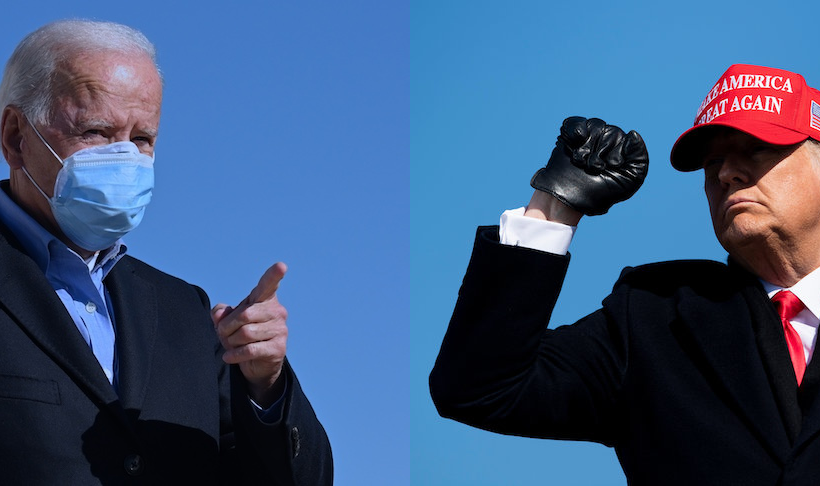Donald Trump’s 2016 election victory stunned the world. It also uprooted the electoral map: Trump won narrow victories in states which had voted Democratic for decades. This year, many forecasters have been keen to stress the unpredictability of an election that may well redefine that map again.
Holding an election in a pandemic makes predictions tough: while most Republican voters are still happy to vote in person, most Democrats have cast absentee or early ballots – which may be counted at different times or rejected at different rates. It’s also unpredictable because the Trump era has shattered many usual voting habits, with many blue-collar working-class communities now solidly Republican – and Democrats making huge inroads in former conservative bastions. It’s clear that diversifying states like Arizona, Georgia and Texas are moving in the Democrats’ direction, but we don’t know if it will be enough for Biden to take any of them across the line.
270 electoral votes are needed to win the Presidency. Around 223 are fairly secure for Joe Biden, while just 132 are for President Trump. Below are ten key states worth watching tonight, from which Biden needs to collect 47 votes, while Donald Trump must rack up 138. With some states slow to count their absentee ballots and others able to receive them after election day, we may not know the result of several states for days to come.
Georgia
- Electoral votes: 16
- 2016: 51% Trump / 46% Clinton
- FiveThirtyEight prediction: 50% Biden / 49% Trump
- First results from: 12am GMT
- Most results expected by: 4am GMT
The emergence of Georgia as a battleground late in this election would have stunned many onlookers just a year ago. But demographic change, especially the incredible growth of the liberal metropolis of Atlanta – led by an influx of millennials – has turned the Peach State purple. The 2018 midterms saw rising star Stacey Abrams come within 1.4 points of winning the Governor’s mansion, and the Democrats are hoping to build on her momentum.
The past week has seen visits from Donald Trump, Joe Biden, Barack Obama and Kamala Harris, a sign of how close both sides view the battle for Georgia’s 16 electoral votes. Biden has a virtual lock on the state’s African American vote, who make up 30 per cent of the electorate, meaning he does not need much more than a quarter of the white vote to win overall. Georgia also has close crucial Senate races, which – in the likely event that no candidate reaches 50 per cent – will head to a runoff on 5 January (yes, this election could last until then).
In Georgia, it’s all about the Atlanta suburbs, especially Gwinnett and Cobb counties, where Biden wants to improve on Abrams’ 57 and 54 per cent, respectively. He’ll also want turnout to be high in ‘Black Belt’ counties like Dougherty, where the pandemic and economic decline have hit hard.
Florida
- Electoral votes: 29
- 2016: 49% Trump / 48% Clinton
- FiveThirtyEight prediction: 51% Biden / 49% Trump
- First results from: 12am GMT (first ballots will strongly favour Democrats)
- Most results expected by: 4am GMT (Republican in person ballots counted last)
As I wrote here on Monday, Florida is a perennial tossup that leaves Democrats with an enduring sense of dread. Hillary Clinton lost here by 1.2 points in 2016 and while the Blue Wave was crashing down nationally in 2018, Democrats fell back in Florida, losing a Senate seat and failing to take the Governor’s mansion for a sixth time in a row. Demographic change is making the state both older and more Latino – and while these groups tend to favour the Republicans and Democrats respectively, Biden is surging among retirees and Trump is closing the gap with the state’s Latino voters. While forecasters differ in their predictions here, Republicans have the better operation and their voter coalition has a more reliable turnout than the Democrats’. Results in Florida will come in thick and fast tonight: Biden can get to 270 Electoral Votes without winning here – while a loss would block Trump’s path to re-election.
Watch both the margin and turnout in deep blue Miami-Dade county, where Trump is hoping his numbers among Cuban voters will grow and Democratic turnout will be down – Hillary Clinton got 64 per cent and 624,146 votes here in 2016. Team Biden will be looking to flip swing counties like Pinellas (St Petersburg) and Duval (Jacksonville), while denting Trump’s margin in retiree communities like Sumter County, home to The Villages, where the Republican got 69 per cent in 2016.
North Carolina
- Electoral votes: 15
- 2016: 51% Trump / 47% Clinton
- FiveThirtyEight prediction: 51% Biden / 49% Trump
- First results from: 12.30am GMT (first ballots will strongly favour Democrats)
- Most results expected by: 4am GMT (Some absentee ballots until 12 November)
Like much of the South, the Tarheel State transitioned from being reliably Democratic to consistently Republican in the 1960s. However, since Barack Obama’s narrow win in 2008, the state has remained close. North Carolina is home to several large, growing cities – especially Charlotte and Raleigh – as well as prominent universities, full of just the kind of educated voters who have moved sharply against President Trump. This, combined with a surge in African American turnout, makes the Republicans’ chances in North Carolina seem dicey. Donald Trump has made no fewer than 14 visits to the state this year, more than any other swing state save Florida. All eyes are, however, on the Senate race here: Republican Thom Tillis seemed an underdog for re-election until his Democratic opponent was caught in a sexting scandal. The outcome may well decide who controls the Senate.
Watch to see if Biden improves on Hillary Clinton’s vote share in Wake and Mecklenburg counties (57 and 62 per cent in 2016). He will also be looking to flip formerly Democratic Robeson, where two fifths of the population are Native American.
Ohio
- Electoral votes: 18
- 2016: 52% Trump / 44% Clinton
- FiveThirtyEight prediction: 50% Trump / 50% Biden
- First results from: 12.30am GMT (first votes likely to favour Democrats)
- Most results expected by: 3am GMT (additional absentee votes until 13 November)
This classic bellwether has gone for the candidate who won the White House in every election since 1964 – and all but two since 1896. But Ohio has drifted to the right of the nation over the past decade, driven by a Democratic collapse in the Appalachian parts of the state. While Obama twice won narrowly here, Donald Trump’s eight-point blowout in 2016 seemed to symbolise the end of the state as a key battleground. Polls, however, show the race for the state’s 18 electoral votes is close – but in 2018 they overestimated Democrats in the Governor’s election, suggesting the Red team may still have the upper hand. Biden’s surprise visit to Cleveland yesterday indicates the Democrats believe the state is in play. Most forecasters disagree.
To win Ohio back into the blue column, Biden will be looking for gains in the suburbs of Cincinnati, Dayton, Cleveland and Columbus, and in places like Hamilton and Summit counties, where Hillary Clinton won 53 and 52 per cent respectively.
Pennsylvania
- Electoral votes: 20
- 2016: 49% Trump / 48% Clinton
- FiveThirtyEight prediction: 52% Biden / 47% Trump
- First results from: 1am GMT (first ballots expected to strongly favour Republicans)
- Most results expected by: Next week (Democratic-leaning mail-in ballots counted last)
Democratic strategist James Carville is said to have described Pennsylvania as ‘Philadelphia and Pittsburgh with Alabama in between’. Its demographic variety – with big cities, wealthy suburbs, Rust Belt and a large chunk of Appalachia – has meant the state has been hotly contested in almost every election since 1932. Donald Trump won here by 0.72 points in 2016, while Democrats bounced back in the 2018 midterms – winning all statewide offices by large margins. Originally from Scranton in Northeast Pennsylvania, Joe Biden has made much of his roots in the state, which forecasters view as the most likely to decide the election. Polls show him with a narrower lead than in other parts of the ‘Blue Wall’. In truth, Pennsylvania has always been a Purple state.
Pennsylvania has strict rules around correct signatures and envelopes for mail-in ballots and the parties have already been fighting it out in court to decide which votes get accepted and rejected. While many had their doubts in 2016, local Democrats are extremely confident this time.
Erie and Northampton, two of the three counties to flip to Trump in 2016, are key Blue Collar targets for the Biden campaign to win back. Also see if Biden racks up wide margins in the Philadelphia suburban counties of Delaware, Chester Montgomery and Bucks, where big wins could lock Donald Trump out of the White House.
Michigan
- Electoral votes: 16
- 2016: 48% Trump / 47% Clinton
- FiveThirtyEight prediction: 54% Biden / 45% Trump
- First results from: 1am GMT (first ballots expected to strongly favour Republicans)
- Most results expected by: Friday (Democratic-leaning mail-in ballots counted last)
Hillary Clinton’s campaign realised they were in trouble in Michigan in the final week of the 2016 election, and dispatched the then-President Obama to a rally in Detroit. Late polls showing the race was close were the canary in the coal mine of the wider fall of the Blue Wall. While African American turnout in Detroit was subdued, Donald Trump ran up votes in rural parts of the state to win by 0.23 points. Biden now has had a solid lead in all Michigan polls and few expect the Republicans to hold on here.
Joe Biden will be hoping to flip Kent County, a traditionally Republican area home to the city of Grand Rapids, that was the power base of President Gerald Ford. Conversely, Donald Trump will be looking to hold on to Macomb County, a traditionally Democratic blue-collar suburbia in Northeast Detroit, which he won by almost 12 points in 2016.
Wisconsin
- Electoral votes: 10
- 2016: 47% Trump / 46% Clinton
- FiveThirtyEight prediction: 54% Biden / 46% Trump
- First results from: 2am GMT
- Most results expected by: Wednesday 1pm GMT
In 2016, the Clinton campaign thought they had Wisconsin so far in the bag, that she failed to visit the state – and when Donald Trump won there by 0.77 points, electoral forecasters were stunned. Since Barack Obama scored landslide wins in the Badger State (no, really) in 2010, Republicans have built a formidable machine in Wisconsin. Home to both Kenosha – where Jacob Blake was shot by police – and the nation’s most significant Covid spike, racial justice and the pandemic will weigh heavily on the minds of voters. Polls show Joe Biden riding high, and along with Michigan, it’s the part of the Democrats’ ‘Blue Wall’ most likely to be rebuilt.
Donald Trump actually won fewer votes here in 2016 than Mitt Romney did in 2012, due to a huge drop in Democratic turnout. Biden will be hoping to bring his numbers back up above 330,000. The WOW counties (Waukesha, Ozaukee and Washington) outside the city are some of the most resiliently conservative suburbs in America – watch what happens to Donald Trump’s margins here: he won by 27, 19 and 40 points respectively in 2016.
Arizona
- Electoral votes: 16
- 2016: 50% Trump / 45% Clinton
- FiveThirtyEight prediction: 51% Biden / 48% Trump
- First results from: 2am GMT (first votes will favour Democrats)
- Most results expected by: 5am GMT (some absentee votes until Friday)
Hillary Clinton’s foray into Arizona in 2016 has since been seen as a symbol of the hubris of a campaign that didn’t realise it was playing defence. However, demographic changes in the state have long given Democrats cause for hope: three quarters of the state’s population now live in the growing Phoenix and Tuscon metro areas. The revolt of suburban women against the President is most likely to be felt on the outskirts of these sprawling cities, which gave Democrats a Senate win here in 2018. Once a bastion of small-government ‘Goldwater Republicans’, several of the state’s most prominent Republicans are involved in the Never Trump movement – with former Senator Jeff Flake and Cindy McCain (the widow of former Presidential candidate John McCain) backing Joe Biden. Astronaut Mark Kelly seems set to defeat Republican Senator Martha McSally here, who was appointed to fill McCain’s former seat in 2019.
Maricopa County, home to Phoenix, is the largest swing county in the nation. It hasn’t been won by a Democratic presidential candidate since 1948, though Hillary Clinton came within three points in 2016.
Texas
- Electoral votes: 38
- 2016: 53% Trump / 43% Clinton
- FiveThirtyEight prediction: 51 Trump / 49% Biden
- First results from: 2am GMT (first votes will favour Democrats)
- Most results expected by: 5am GMT (some on Wednesday)
In electoral politics, demographics eventually become destiny – and Texas is changing fast. Cities like Austin and Dallas have become millennial magnets, especially for those looking for cheaper alternatives to cities like San Francisco and New York. Trump’s 2016 nine-point win here in 2016 was the GOP’s closest in 20 years and Beto O’Rourke came within three points of unseating Ted Cruz in 2018. Texas is an expensive and difficult state to campaign in, and Team Biden’s approach has been compared to a big cat eyeing its prey: circling around, but never quite pouncing. Despite this, Kamala Harris was sent to the state last week and Michael Bloomberg has spent $1 million (£770,000) a day on pro-Biden adverts in the final week. Unlike in Georgia, Republicans feel relatively safe here this cycle. The big prize in Texas, however, may not be the Presidency, but the State House, where Democrats hope to flip enough seats to have a big enough role in redistricting next year.
Key to a Biden upset would be the Democrat improving on Beto O’Rourke’s 2018 vote shares in Austin (74 per cent), Dallas (66 per cent), San Antonio (60 per cent) and Houston (58 per cent), as well as improving turnout in the Rio Grande Valley in the south of the state, where Democratic turnout has been sluggish.
Minnesota
- Electoral votes: 10
- 2016: 47% Clinton / 45% Trump
- FiveThirtyEight prediction: 54% Biden / 45% Trump
- First results from: 2am GMT (first votes likely to favour Democrats)
- Most results expected by: 5am GMT
In 2016, this was the only part of the Blue Wall to buckle but not fall, as Hillary Clinton clung on to the state by 1.5 points. If the pollsters are wrong, and Donald Trump is able to pick off a Democratic state, it would be here – despite Minnesota not having voted Republican since 1972. Rural Democratic support, centred on the Iron Range in the north of the state, has been eroding for some years. However, over 60 per cent of Minnesotans live in the Minneapolis-St Paul metro area, where – like almost all big cities in America – the President’s stock has fallen since 2016. These countervailing forces were seen in the 2018 midterm elections, where Democrats gained two suburban congressional districts, but Republicans flipped two rural Democratic districts. Donald Trump would love to win here, but Minnesota’s surprisingly urbanised electorate seems likely to deny him victory.
To score a shock win, Donald Trump will want to improve on the 40 per cent he received in St Louis county (Duluth) in 2016, while holding down Democratic shares in the Minnesota suburbs.
Got something to add? Join the discussion and comment below.
Get 10 issues for just $10
Subscribe to The Spectator Australia today for the next 10 magazine issues, plus full online access, for just $10.




















Comments
Don't miss out
Join the conversation with other Spectator Australia readers. Subscribe to leave a comment.
SUBSCRIBEAlready a subscriber? Log in